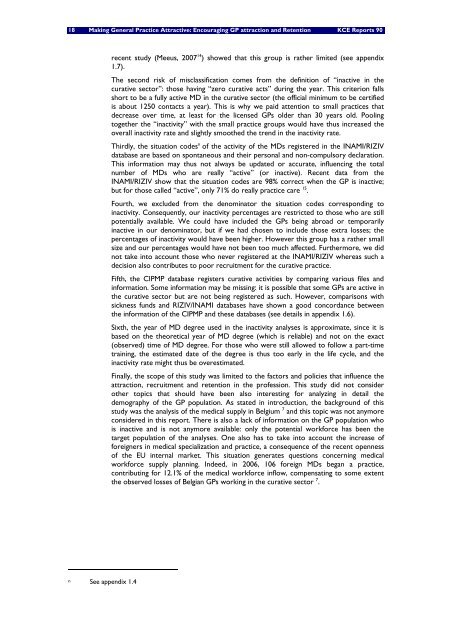Download the report (150 p.) - KCE
Download the report (150 p.) - KCE
Download the report (150 p.) - KCE
You also want an ePaper? Increase the reach of your titles
YUMPU automatically turns print PDFs into web optimized ePapers that Google loves.
18 Making General Practice Attractive: Encouraging GP attraction and Retention <strong>KCE</strong> Reports 90<br />
recent study (Meeus, 2007 14 ) showed that this group is ra<strong>the</strong>r limited (see appendix<br />
1.7).<br />
The second risk of misclassification comes from <strong>the</strong> definition of “inactive in <strong>the</strong><br />
curative sector”: those having “zero curative acts” during <strong>the</strong> year. This criterion falls<br />
short to be a fully active MD in <strong>the</strong> curative sector (<strong>the</strong> official minimum to be certified<br />
is about 1250 contacts a year). This is why we paid attention to small practices that<br />
decrease over time, at least for <strong>the</strong> licensed GPs older than 30 years old. Pooling<br />
toge<strong>the</strong>r <strong>the</strong> “inactivity” with <strong>the</strong> small practice groups would have thus increased <strong>the</strong><br />
overall inactivity rate and slightly smoo<strong>the</strong>d <strong>the</strong> trend in <strong>the</strong> inactivity rate.<br />
Thirdly, <strong>the</strong> situation codes n of <strong>the</strong> activity of <strong>the</strong> MDs registered in <strong>the</strong> INAMI/RIZIV<br />
database are based on spontaneous and <strong>the</strong>ir personal and non-compulsory declaration.<br />
This information may thus not always be updated or accurate, influencing <strong>the</strong> total<br />
number of MDs who are really “active” (or inactive). Recent data from <strong>the</strong><br />
INAMI/RIZIV show that <strong>the</strong> situation codes are 98% correct when <strong>the</strong> GP is inactive;<br />
but for those called “active”, only 71% do really practice care 15 .<br />
Fourth, we excluded from <strong>the</strong> denominator <strong>the</strong> situation codes corresponding to<br />
inactivity. Consequently, our inactivity percentages are restricted to those who are still<br />
potentially available. We could have included <strong>the</strong> GPs being abroad or temporarily<br />
inactive in our denominator, but if we had chosen to include those extra losses; <strong>the</strong><br />
percentages of inactivity would have been higher. However this group has a ra<strong>the</strong>r small<br />
size and our percentages would have not been too much affected. Fur<strong>the</strong>rmore, we did<br />
not take into account those who never registered at <strong>the</strong> INAMI/RIZIV whereas such a<br />
decision also contributes to poor recruitment for <strong>the</strong> curative practice.<br />
Fifth, <strong>the</strong> CIPMP database registers curative activities by comparing various files and<br />
information. Some information may be missing: it is possible that some GPs are active in<br />
<strong>the</strong> curative sector but are not being registered as such. However, comparisons with<br />
sickness funds and RIZIV/INAMI databases have shown a good concordance between<br />
<strong>the</strong> information of <strong>the</strong> CIPMP and <strong>the</strong>se databases (see details in appendix 1.6).<br />
Sixth, <strong>the</strong> year of MD degree used in <strong>the</strong> inactivity analyses is approximate, since it is<br />
based on <strong>the</strong> <strong>the</strong>oretical year of MD degree (which is reliable) and not on <strong>the</strong> exact<br />
(observed) time of MD degree. For those who were still allowed to follow a part-time<br />
training, <strong>the</strong> estimated date of <strong>the</strong> degree is thus too early in <strong>the</strong> life cycle, and <strong>the</strong><br />
inactivity rate might thus be overestimated.<br />
Finally, <strong>the</strong> scope of this study was limited to <strong>the</strong> factors and policies that influence <strong>the</strong><br />
attraction, recruitment and retention in <strong>the</strong> profession. This study did not consider<br />
o<strong>the</strong>r topics that should have been also interesting for analyzing in detail <strong>the</strong><br />
demography of <strong>the</strong> GP population. As stated in introduction, <strong>the</strong> background of this<br />
study was <strong>the</strong> analysis of <strong>the</strong> medical supply in Belgium 7 and this topic was not anymore<br />
considered in this <strong>report</strong>. There is also a lack of information on <strong>the</strong> GP population who<br />
is inactive and is not anymore available: only <strong>the</strong> potential workforce has been <strong>the</strong><br />
target population of <strong>the</strong> analyses. One also has to take into account <strong>the</strong> increase of<br />
foreigners in medical specialization and practice, a consequence of <strong>the</strong> recent openness<br />
of <strong>the</strong> EU internal market. This situation generates questions concerning medical<br />
workforce supply planning. Indeed, in 2006, 106 foreign MDs began a practice,<br />
contributing for 12.1% of <strong>the</strong> medical workforce inflow, compensating to some extent<br />
<strong>the</strong> observed losses of Belgian GPs working in <strong>the</strong> curative sector 7 .<br />
n See appendix 1.4
















